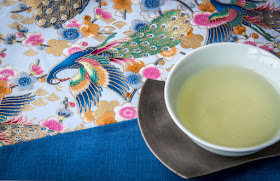Before the tea class, I took the Penn State's Tea Institute members to hot springs in Wulai. The view on the green mountain behind the river was just stunning. It was like staring at a Chinese Shan Shui painting while soaking in hot water.
We brewed 3 teas while we were there. The winter 2015 Da Yu Ling felt fresh and pure. For Ryan and me, this was the perfect match with the hot spring experience. Teddy and Sam loved the thicker and fruitier Alishan Tie Guan Yin, while Andres preferred the warm and sweet winter 2014 Concubine Oolong.
The teas added to the hot spring experience. Their pure aromas seemed to clean us from the inside, while the hot water was cleaning us from the outside. It gave us a feeling of complete satisfaction.
For their last class in Taiwan, we brewed the same
spring 2003 Hung Shui Oolong from Yong Lung using 3 teapots made from different Yixing clays to experience how each teapot impacts the tea. We didn't just use the same water and kettle, I also instructed that we use a medium strength pour for all the teapots for the first brew. So, Teddy, started with a zhuni teapot. It had a certain sharpness, powerful scents and depth.
I continued with my antique zisha.
The brew was the most balanced between the roasting and the freshness.
Then we tasted the mellowing transformation of the duanni. This one was the smoothest and sweetest.
As a bonus to this comparison, Sam also brewed with my golden silver teapot. The scents were particularly bright and the taste light, almost
superficial! (Note: we used fewer leaves for this teapot, because its
high heat conductivity provides the most flavor extraction).
This teapot isn't very suited to the character of a Hung Shui Oolong,
but it's interesting to see how few leaves can release so many wonderful
aromas! Like a neutral porcelain gaiwan, the silver doesn't hide any
defects and actually magnifies the good and the bad from the tea. So
this was a good way to appreciate the quality of this tea and then
compare how the Yixing teapots underline the scents, the sweetness, the
harmony and/or the freshness from the tea.
We were able to achieve very good results with all 4
teapots. The zisha and the duanni felt the most suited to express the
complex character of this aged roasted Oolong. However, we also noted
that a careful brewing also mattered to get the best results from the
teapot. Once you know how your teapot performs, you can adapt your
brewing in accordance. For instance, since the duanni is good at making
the tea harmonious and mellow, I poured the hot water with more strength
than for the other teapots on the second brew.
Tasting this aged 2003 Hung Shui Oolong left us completely relaxed with a warm and sweet feeling leaping from the mouth to the rest of our body. This felt again like a hot spring shower, one that relaxes and calms you from the inside!


























































